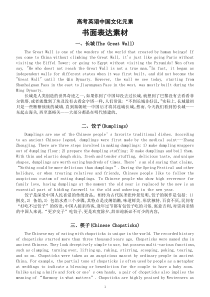 DOC
DOC
【文档说明】高中英语高考中国文化元素书面表达素材(长城+饺子+筷子+中国功夫).doc,共(5)页,99.000 KB,由鹿哥教育上传
转载请保留链接:https://www.ichengzhen.cn/view-218397.html
以下为本文档部分文字说明:
1高考英语中国文化元素书面表达素材一、长城(TheGreatWall)TheGreatWallisoneofthewondersoftheworldthatcreatedbyhumanbeings!IfyoucometoChinawi
thoutclimbingtheGreatWall,it'sjustlikegoingPariswithoutvisitingtheEiffelTower;orgoingtoEgyptwithoutvisitingtheP
yramids!Menoftensay,"HewhodoestnotreachtheGreatWallisnotatrueman."Infact,itbeganasindependentwallsfordifferentstateswhenitwasfirstbu
ilt,anddidnotbecomethe"GreatWall"untiltheQinDynasty.However,thewallweseetoday,startingfromShanhaiguanPassintheeastto
JiayunguanPassinthewest,wasmostlybuiltduringtheMingDynasty.长城是人类创造的世界奇迹之一。如果你到了中国却没去过长城,就想到了巴黎没有去看看菲尔铁塔,
或者就像到了埃及没有去看金字塔一样。人们常说:“不到长城非好汉。”实际上,长城最初只是一些断断续续的城墙,直到秦朝统一中国后才将其连城长城。然而,今天我们看到的长城——东起山海关,西至嘉峪关——大部分都是在明代
修建的。二、饺子(Dumplings)DumplingsareoneoftheChinesepeople’sfavoritetraditionaldishes.AccordingtoanancientChineselegen
d,dumplingswerefirstmadebythemedicalsaint---ZhangZhongjing.Therearethreestepsinvolvedinmakingdumplings:1)makedum
plingwrappersoutofdumplingflour;2)preparethedumplingstuffing;3)makedumplingsandboilthem.Withthinandelasticdoughskin,fresha
ndtenderstuffing,delicioustaste,anduniqueshapes,dumplingsarewortheatinghundredsoftimes.There’sanoldsayingthatclaims,“Nothin
gcouldbemoredeliciousthandumplings”.DuringtheSpringFestivalandotherholidays,orwhentreatingrelativesandfriends,Chinesepeopleliketofollowt
heauspiciouscustomofeatingdumplings.ToChinesepeoplewhoshowhighreverenceforfamilylove,havingdumplingsatthemomenttheoldyearisreplac
edbythenewisanessentialpartofbiddingfarewelltotheoldandusheringinthenewyear.饺子是深受中国人民喜爱的传统食品。相传为古代医圣张仲景发明。饺子的制作是包括:1)
擀皮、2)备馅、3)包馅水煮三个步骤。其特点是皮薄馅嫩,味道鲜美,形状独特,百食不厌。民间有“好吃不过饺子”的俗语。中国人接亲待客、逢年过节都有包饺子吃的习俗,寓意吉利。对崇尚亲情的中国人来说,“更岁交子”吃饺子,更是欢度除夕、辞旧迎新必不可少的内容。三、筷子(ChineseC
hopsticks)TheChinesewayofeatingwithchopsticksisuniqueintheworld.Therecordedhistoryofchopsticksstartedmorethanthreethou
sandyearsago.ChopstickswerenamedzhuinancientChinese.Theylookdeceptivelysimpletouse,butpossessmulti-variousfunctions,suchasc
lamping,turningover,liftingup,raking,stirring,scooping,poking,tearing,andsoon.Chopsticksweretakenasanauspicio
usmascotbyordinarypeopleinancientChina.Forexample,thepartialtoneofchopsticksisoftenusedbypeopleasame
taphoratweddingstoindicateablessingorbenedictionforthecoupletohaveababysoon.Unlikeusingaknifeandforkorone’sownhands,apairofc
hopsticksalsoimpliesthemeaningof“Harmonyiswhatmatters”.ChopsticksarehighlypraisedbyWesternersas2ahallmarkofancientorientalcivil
ization.中国人使用筷子就餐的方式在世界上独树一帜。有史记载用筷的历史已有三千多年。筷子古时称为箸,它看似简单,但却同时具有夹、拨、挑、扒、拌、撮、戳、撕等多种功能。中国民间视筷子为吉祥之物,如婚俗中将筷子隐喻为快生贵子的祝福等。与使用刀
叉以及手抓的方式不同,成双结对的筷子含有“和为贵“的意蕴。西方人赞誉筷子是古老的东方文明。【拓展1】TheStoryofChopsticks(1)筷子的故事⑴ChopsticksareusedeverydayinChina.⑵NowI'dliketotakethisopport
unitytosharetheirinterestinghistorywithyou.⑶Ithinkyou'llagreethatevenanordinaryitemusedindailylifecanhaveafascinatingsto
ry.⑷AlthoughchopsticksoriginatedinChina,theyarewidelyusedinmanyAsiancountries.⑸Thefirstchopstickswere
madefromboneandjade.⑹IntheSpringandAutumnperiod,copperandironchopstickscameintobeing.⑺Inancienttimes,therichusedjadeorgoldchopsti
ckstodisplaytheirwealth.⑻Manykingsandemperorsusedsilverchopstickstoseeiftheirfoodhadbeenpoisoned.⑼Chopsticksa
retraditionallyplacedinbrides'dowries,because"chopsticks"inChineseispronounced"kuaizi",whichsoundslike"getasonsoon
."⑽ManyforeignfriendstrytousechopstickswhentheyvisitChina.⑾EventheformerpresidentoftheUnitedStatesRichardNixon,usedchopsticksatthewelcomingban
quetheldinhishonor.⑿Assoonashelefthistable,aforeigndiplomatgrabbedhischopsticksasahistoricalsouvenir.
⑴中国人每天都在使用筷子。⑵现在我想借这个机会和大家一起聊一些有关于筷子历史的有趣故事。⑶我想你会赞同即使是日常生活中一件小物品也会有其引人入胜的故事。⑷虽然筷子起源于中国,但现在很多的亚洲国家都在使用。⑸最早的筷子是用骨头和玉制成的。⑹在春秋时代又出现了铜制和铁制的筷子。⑺在古代,富人
家用玉筷子或金筷子以显示其家庭的富有。⑻许多帝王用银制的筷子以检查他们的食物中是否被人投了毒。⑼筷子在传统上是被当作新娘的嫁妆的,因为“筷子”在汉语中读作“kuaizi”,听起来很像“快得儿子”。⑽许多外国
朋友在访问中国的时候都使用筷子。⑾甚至是美国前总统尼克松在为其到来而举办的欢迎宴会上也使用了筷子。⑿他刚一离开桌子,一名国外的外交人员就抓起了他的筷子,把它作为了具有历史意义的纪念3品。【拓展2】TheSto
ryofChopsticks(2)筷子的故事⑴InancientChina,chopstickssignifiedfarlorethantoolsthattakefoodtothemouth;theyalsosignifie
dstatusandrules,“can”and”can’t”.⑵DuringtheNorthernSongDynasty,anofficialnamedTangSuoncehaddinnerwiththeemperor.Hewasnotwellinformedinnobletable
etiquetteandsolaiddownhischopstickshorizontallyonthetablebeforetheemperordid.Asaresult,hewasexpatriatedtoafrontierareaforpenalservitude.⑶Inancie
nteatingetiquette,therewereoveradozentaboosconceningchopsticks.Forexample,theycouldnotbeplacedverticallyintoadish,a
sthiswasthewayofmakingsacrificestothedead.⑴在古代中国,筷子不仅仅是把食物送到口中的餐具,它被赋予了重要的内涵和“能”和“不能”的规矩。⑵北宋朝时,一个叫唐肃的官员陪皇帝
进膳。他不了解用餐时使用筷子的礼仪,在皇帝还没有吃完时,他把筷子横放在桌子上,表示他不想再吃了。结果这位官员被发配边疆。⑶在古代的饮食礼仪中,筷子的使用方法的禁忌有十多种。比如,忌将筷子竖直插入菜盘或饭碗中,因为这代表为死人上坟。
四、中国功夫(Chinesekungfu)Chinesekungfu,orChinesemartialarts,carriestraditionalChinesecultureinabundance.Itisatraditio
nalChinesesportwhichappliestheartofattackanddefenceincombatandthemotionsengagedwithaseriesofskillandt
ricks.ThecoreideaofChinesekingfuisderivedfromtheConfuciantheoryofboth“themeanandharmony”and“cultivati
ngqi”(otherwiseknownasnourishingone’sspirit).Meanwhile,italsoincludesthoughtsofTaoismandBuddhism.Chinese
kungfuhasalonghistory,withmulti-varioussectsandmanydifferentboxingstyles,andemphasizescouplinghardnesswithsoftnessandinte
rnalandexternaltraining.Itcontainstheancientgreatthinkers’ponderingoflifeandtheuniverse.Theskillsinwieldingthe18kindsofweaponsnamedbythe
latergenerationsmainlyinvolvetheskillsofbare-handedboxing,suchasshadowboxing(Taijiquan),formandwillboxing(Xingyiquan),eighttrigr
ampalm(Baguazhang),andtheskillsofkungfuweaponry,suchastheskillofusingswords,spears,two-edgedswordsandhalberd
s,axes,tomahawks,kooks,prongsandsoon.中国功夫即中国武术,是将技击寓于搏斗和套路运动之中的中国传统体育项目,承载着丰富的中国民族传统文化。其核心思想是儒家的中和养气之说,同时兼
容了道家、释家的思想。中国武术源远流长、流派林立、拳种繁多,讲究刚柔并济、内外兼修,蕴含着先哲们对生命和宇宙的参悟。后世所称十八般武艺,主要指:徒手拳艺,如太极拳、形意拳、八卦掌等;器械功夫,如刀枪剑戟、斧钺钩叉等。4【拓展】⑴ChineseKungFuismag
nificentandprofoundbutit’sunfortunatethatalotofithasnotbeenpasseddown.⑵Taijiquancanmakeyoufeelatpeac
e.Inadditiontoemphasizingmatchingthemovementswithyourbreathing,itisgoodforyourhealthtoo.⑶Theprimaryreasonforpracticingkungfuisforhealthreasons.Defens
eisofsecondaryimportanceandhurtingothersisabolutelyunacceptable.⑴中国功夫博大精深,可惜有很多已经失传了。⑵太极拳可以使人心境平和,加上它注重呼吸配合动作,对身体也有好处。
⑶练武的主要目的在于锻炼身体,其次是防身,至于用来伤人是万万不可以的。ThereismuchmoretoKungFuthanJackieChanorBruceLee.KungFuisanartform,andalso,verygoodforyou.功夫并不只是指成龙或
李小龙,它是一种艺术形式,而且对你很有好处。ManystylesofKungFuarebasedontheideasofnature.Ancientboxingmastersoftendevelopedtheirfightingtechniquesbyobserving
theworldaroundthem.Animals,birds,andinsectsprovidedthebasisformanysystemsofKungFudevelopedinthepast.很
多功夫招式来源于对自然界的想象。古代拳术大师常常通过观察他们周围的世界改进拳术技法。动物、鸟类和昆虫为过去很多功夫的系统发展提供了基础。ManyofthehardformsofKungFucamefromaBuddhistMonasterycalled“S
haolin”.AnIndianpriestnamedTamocametolivetherenearly1500yearsagou.Accordingtolegend,Tamoarrivedatthemonasterywherehefoundthemonksinpoorphysical
condition.Becausetheycouldn’tstayawakeduringmeditation,Tamointroducedaseriesof18exercisedesignedtofeedbothbodyandmind.Thesemovem
entsaresaidtohavemergedwithself-defensetacticsstudiedintheShaolinTemple.很多硬功夫都出自叫“少林”的佛教寺庙。大约1500年前,有个叫达摩的印度僧人来到这里。传说他来到寺庙,发现那里的和尚
身体状况很不好。因为他们在坐禅时候不能保持清醒,达摩就传授给他们一套十八手拳法,目的是锻炼他们的身心。据说这些动作融合了他在少林寺研究的防身术。IsuggestasoftformofKungFu,calledT
aiQi.ItcomesfromTaoismandit’sverygoodforyourhealth.Throughitstraining,youcangetinnerpeaceandasenseofphysicalandemotionalwellbeing.It’s
oftencalledChineseYoga:theartandscienceofmeditationthroughmovement.我建议你学习一种温和的功夫,叫太极拳。它源于道教,对你的健康非常有好处。通过这种
训练,你能达到内心的平和,以及身体和情绪上的安宁舒适。它经常被人们称作中国瑜伽:通过运动达到沉思冥想的一种艺术和科学。5
 辽公网安备 21102102000191号
辽公网安备 21102102000191号
 营业执照
营业执照